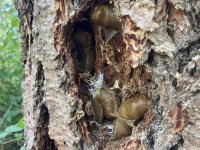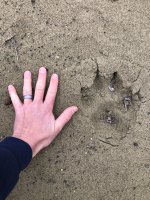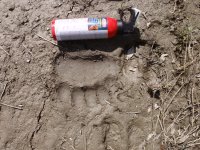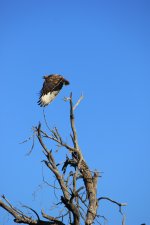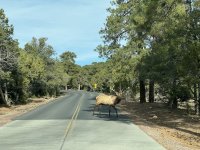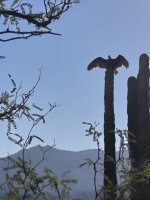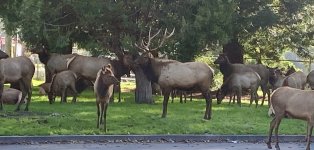AbleGuy
Officious Intermeddler
But on a more serious note… We also were thrilled to have a rare sighting of the infamous nocturnal, carnivorous, pine bark banana slug.
For many years, scientists have tried to study these tiny, voracious night hunting members of the Gastropoda class but have been unsuccessful because they are very, very difficult to find and observe during the daytime hours, if at all.
Once a year, these slimy sewage green colored slugs gather in small groups, slithering high up in the rough bark of white pine trees in the northwest forests to find and hide together in shallow cavities carved into the bark by red belly sap suckers.
These gross looking wet skinned leaf eating creatures will then pack themselves tightly into these holes, creating almost an impenetrable mass of hard to grasp gelato green mucousy flesh, in defense against attacks from hungry predators.
The fact that they can climb up the rough bark of a tree six or 7 feet high to get into these small dark woody caves is a testament to the grippyness of the ooze that they secrete, as most often they are only found crawling on smooth surfaces.
And because they hide deep and packed snugly into these erosions of evergreen bark, they are rarely noticed by people hiking right by them in the thick, dark, wet forests of the Pacific Northwest.
Biologist are unsure of the reason these p e n i s looking slugs gather in small scrums of squirming mass just once a year. The scientists don’t think it’s done for reproduction purposes. But at the same time, they’re simply not sure why the normally solitary slugs choose to cuddle up with other like minded phylum Mollusca in these extremely cramped quarters.
So anyway, here are a few pictures of what we saw of this phenomenon today. If you look at the close-up, can you count accurately how many of them are packed into this one small crevice?
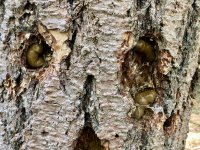

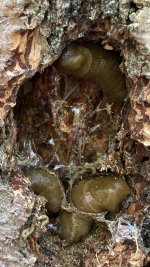
For many years, scientists have tried to study these tiny, voracious night hunting members of the Gastropoda class but have been unsuccessful because they are very, very difficult to find and observe during the daytime hours, if at all.
Once a year, these slimy sewage green colored slugs gather in small groups, slithering high up in the rough bark of white pine trees in the northwest forests to find and hide together in shallow cavities carved into the bark by red belly sap suckers.
These gross looking wet skinned leaf eating creatures will then pack themselves tightly into these holes, creating almost an impenetrable mass of hard to grasp gelato green mucousy flesh, in defense against attacks from hungry predators.
The fact that they can climb up the rough bark of a tree six or 7 feet high to get into these small dark woody caves is a testament to the grippyness of the ooze that they secrete, as most often they are only found crawling on smooth surfaces.
And because they hide deep and packed snugly into these erosions of evergreen bark, they are rarely noticed by people hiking right by them in the thick, dark, wet forests of the Pacific Northwest.
Biologist are unsure of the reason these p e n i s looking slugs gather in small scrums of squirming mass just once a year. The scientists don’t think it’s done for reproduction purposes. But at the same time, they’re simply not sure why the normally solitary slugs choose to cuddle up with other like minded phylum Mollusca in these extremely cramped quarters.
So anyway, here are a few pictures of what we saw of this phenomenon today. If you look at the close-up, can you count accurately how many of them are packed into this one small crevice?



Attachments
Last edited:

